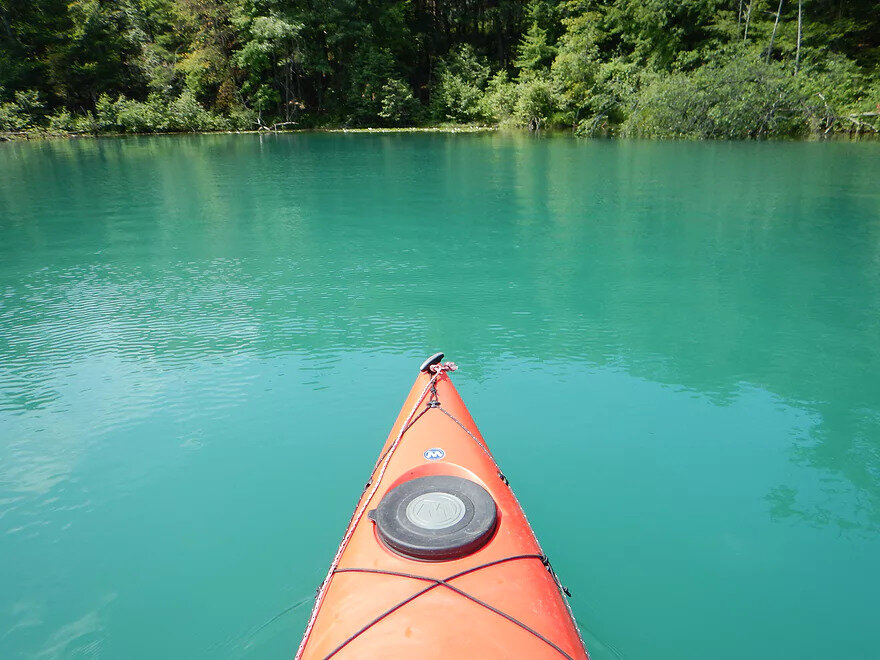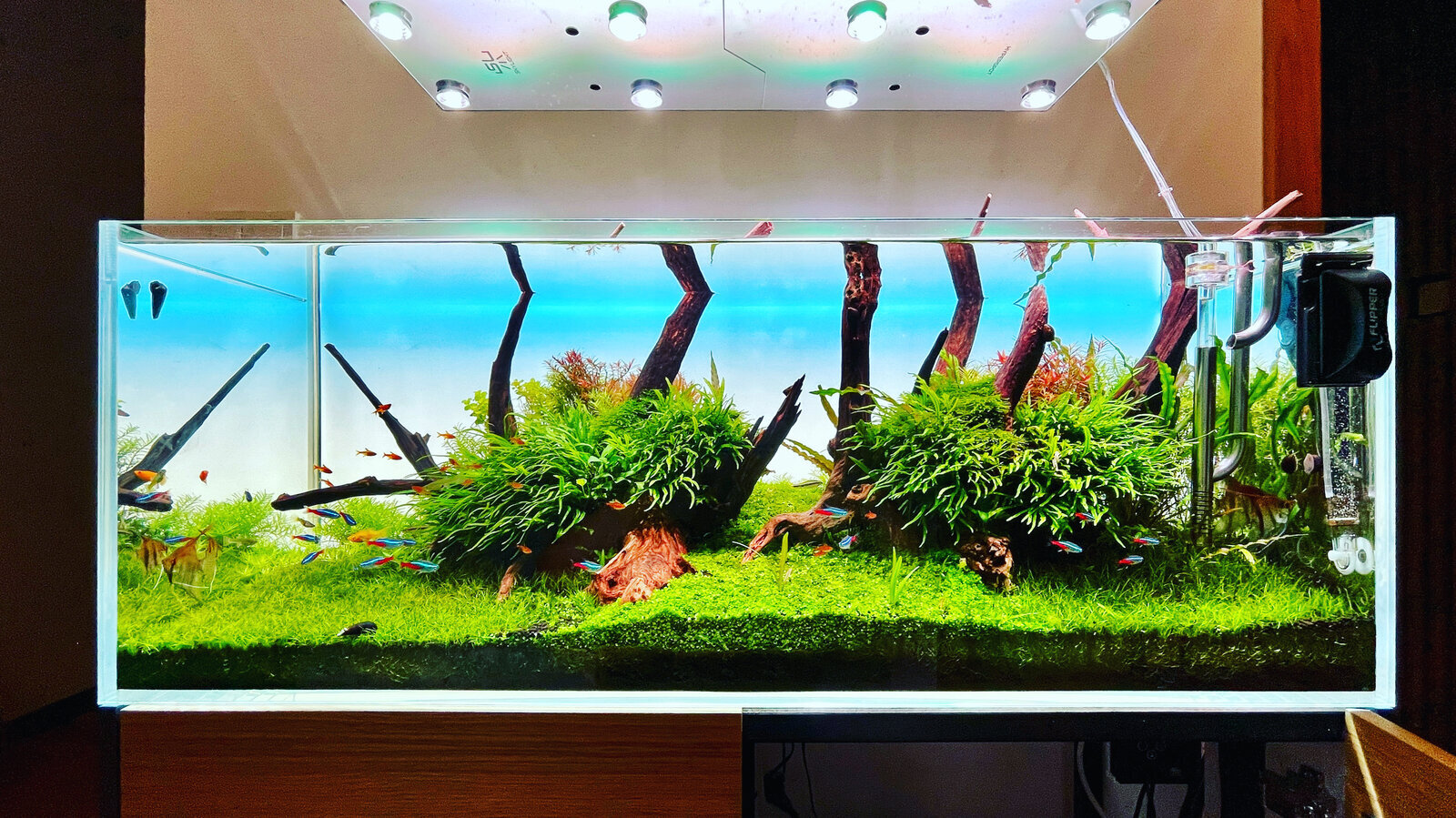Merry Christmas from Ukraine!
-
You are viewing the forum as a Guest, please login (you can use your Facebook, Twitter, Google or Microsoft account to login) or register using this link: Log in or Sign Up
You are using an out of date browser. It may not display this or other websites correctly.
You should upgrade or use an alternative browser.
You should upgrade or use an alternative browser.
Journal Biotope of Chorhun river (Crimea, Ukraine)
- Thread starter Valeriy Aqyar
- Start date
2023.12.26
Chorhun river biotope aquarium (Crimea, Ukraine)

It's a mess...
But it's a perfect mess!
Most of these plants came in during Summer-Autumn period of 2022 and feel great now.
Fishes are having afternoon siesta and will come into view in evening (wild locals are hard to tame 🙁 )

Top view adds mood to the natural look of this biotope, how lush and overgrown it is!
And a little quiz: how many plant species can you find here?
Chorhun river biotope aquarium (Crimea, Ukraine)

It's a mess...
But it's a perfect mess!
Most of these plants came in during Summer-Autumn period of 2022 and feel great now.
Fishes are having afternoon siesta and will come into view in evening (wild locals are hard to tame 🙁 )

Top view adds mood to the natural look of this biotope, how lush and overgrown it is!
And a little quiz: how many plant species can you find here?
_Maq_
Member
Five
hydrophyte
Member
- Joined
- 22 Aug 2009
- Messages
- 1,093
in evening (wild locals are hard to tame 🙁 )
LOL I'd say the locals certainly are "hard to tame". They are an absolute inspiration, in fact.
Tank is looking good!
Did you mention what the soil substrate is?
I hope to make some more headway with aquarium simulation of these hardwater systems like the Chorhun River, chalk streams and marl lakes. We have a lake not very far north of here —it's name is literally Marl Lake —with very hard water and this beautiful clear turquoise blue water, like the Caribbean.
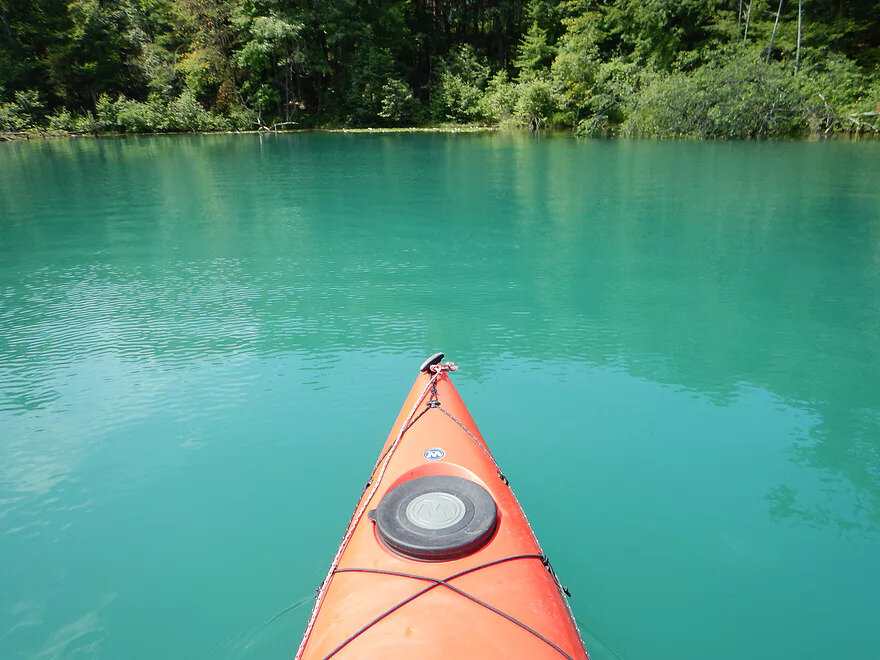
(Source: Crystal River)
Like you mentioned above, this kind of habitat hosts a unique macrophyte flora.
Just this evening while researching these ideas it dawned on me that an illuminated RGB LED tank background tuned to turquoise will further reinforce this idea.

(Source: LIGHTGROUND - RGB aquarium panels)
Attachments
Last edited:
Eleven!Five
Tomorrow, if we survive the russian missile attack this night, I will post the full list of aquatic plant species and some facts about them.
I "cook" a complex substrate, that includes river sand, pebbles, silt and organic litter. Everything comes from local rivers and lakes.LOL I'd say the locals certainly are "hard to tame". They are an absolute inspiration, in fact.
Tank is looking good!
Did you mention what the soil substrate is?
I hope to make some more headway with aquarium simulation of these hardwater systems like the Chorhun River, chalk streams and marl lakes. We have a lake not very far north of here —it's name is literally Marl Lake —with very hard water and this beautiful clear turquoise blue water, like the Caribbean.
Like you mentioned above, this kind of habitat hosts a unique macrophyte flora.
Just this evening while researching these ideas it dawned on me that an illuminated RGB LED tank background tuned to turquoise will further reinforce this idea.
The lake looks gorgeous! Btw, marl is one of components what I use for "cooking" hardwater for my biotope ecosystem.
In your photo the aquarium background effect is created by the Gradient foil and has nothing to deal with the light. But the biotope ecosystem with such background would look fake.
Recreating turquoise gradient effect in a small aquarium is a real challenge. To make a blue colour of water, concentration of minerals would be too high to put in fish and plants.
hydrophyte
Member
- Joined
- 22 Aug 2009
- Messages
- 1,093
I "cook" a complex substrate, that includes river sand, pebbles, silt and organic litter. Everything comes from local rivers and lakes.
The lake looks gorgeous! Btw, marl is one of components what I use for "cooking" hardwater for my biotope ecosystem.
In your photo the aquarium background effect is created by the Gradient foil and has nothing to deal with the light. But the biotope ecosystem with such background would look fake.
Recreating turquoise gradient effect in a small aquarium is a real challenge. To make a blue colour of water, concentration of minerals would be too high to put in fish and plants.
Right here in our area we have limestone bedrock and a lot of the low-lying terrain has old marshy sediments with marl.
Yes I know the illuminated background would look pretty contrived, but I think it's just an option for illustrating the concept and creating the general appearance.
This other project I'm working attempts to create a Green Lake, New York biotope, which is another hardwater system with beautiful clear turquoise water. He did not get a lot of photos, but this still from a short GoPro clip that my friend who collected the field samples recorded shows the view from the microbialite reef off the drop-off and out into the open lake.

I hope I can travel out there some day to see the lake myself and get some more pictures. It is really a fascinating ecosystem.
You know the Black Sea presents additional pretty intriguing biotope possibilities. Check out this article...
Distribution and Composition of Thiotrophic Mats in the Hypoxic Zone of the Black Sea (150–170 m Water Depth, Crimea Margin)
Growing this kind of thing in an aquarium microcosm may seem to be a unlikely, but I think it is doable, I have this other setup in a list of half-finished thing using tubes with O-ring caps to maintain a controlled atmosphere with anoxic conditions...

I still need to finish sealing this thing up and test and get it running. It should be possible to build something comparable, but in a nano tank with some kind of airtight lid for maintaining the hypoxic benthic zone of the Black Sea or similar environment.
A seagrass biotope would be yet another cool idea and very representative for areas of the Black Sea especially around Crimea. Aquarium culture is a challenge, though...
On the Status of Seagrass Communities in the Black Sea
Last edited:
Happy New Year from Ukraine!
On the New Year's Eve we traditionally sing special songs - shchedrivkas to wish a happy and prosperous new year to each other. This tradition has a pagan origin and is only Ukrainian. We sing kolyadkas (carols) on the Christmas Eve, shchedrivkas on the New Year's Eve and posivalkas on January, 1st. All other nations sing only carols.
The most famous shchedrivka is "Shchedryk", known as "Carol of the Bells', though their lyrics and meaning are different.

 en.wikipedia.org
en.wikipedia.org
Ukrainian culture is unique, our musical tradition has more than 1000 year old roots originating from the pre-Christian period of the Rus' (russians call it Kievan Rus trying to distort and falsify Ukrainian history).
And this is what russians so desperately try to destroy - our national identity. Their aim is to conquer our land and assimilate Ukrainians, turn us into other russians, appropriate our heritage and call it also russian.
And this is what awaits Europe if you let us fall...
On the New Year's Eve we traditionally sing special songs - shchedrivkas to wish a happy and prosperous new year to each other. This tradition has a pagan origin and is only Ukrainian. We sing kolyadkas (carols) on the Christmas Eve, shchedrivkas on the New Year's Eve and posivalkas on January, 1st. All other nations sing only carols.
The most famous shchedrivka is "Shchedryk", known as "Carol of the Bells', though their lyrics and meaning are different.

Shchedryk (song) - Wikipedia
Ukrainian culture is unique, our musical tradition has more than 1000 year old roots originating from the pre-Christian period of the Rus' (russians call it Kievan Rus trying to distort and falsify Ukrainian history).
And this is what russians so desperately try to destroy - our national identity. Their aim is to conquer our land and assimilate Ukrainians, turn us into other russians, appropriate our heritage and call it also russian.
And this is what awaits Europe if you let us fall...
2023.12.26
Chorhun river biotope aquarium (Crimea, Ukraine)
View attachment 214196
And a little quiz: how many plant species can you find here?
So here are 11 species of aquatic plants.
Visible:
1. Nuphar lutea / yellow water-lily
2. Sparganium erectum / branched bur-reed
3. Potamogeton nodosus / longleaf pondweed
4. Potamogeton perfoliatus / perfoliate pondweed
5. Ceratophyllum demersum / hornwort
6. Najas marina / spiny naiad
Hidden:
7. Myriophyllum spicatum L / spiked watermilfoil
8. Elodea canadensis / Canadian waterweed
9. Water soldiers / Stratiotes aloides
10. Lemna minor / common duckweed
11. Spirogyra / water silk green algae
Plants # 1, 5, 7, 8, 10, 11 were planted at initial setup and have been feelin' ok since August, 2020.
Plants # 2, 3 were added in summer 2022.
And finally in May and June, 2023 I planted # 4, 6 and 9.
So here we can conclude that most of the temperate aquatic plants are suitable for our home aquaria. They are beautiful and hardy, they don't need a winter cold period.
The only problem I still have to solve is the allelopathy.
hydrophyte
Member
- Joined
- 22 Aug 2009
- Messages
- 1,093
So here are 11 species of aquatic plants.
Visible:
1. Nuphar lutea / yellow water-lily
2. Sparganium erectum / branched bur-reed
3. Potamogeton nodosus / longleaf pondweed
4. Potamogeton perfoliatus / perfoliate pondweed
5. Ceratophyllum demersum / hornwort
6. Najas marina / spiny naiad
Hidden:
7. Myriophyllum spicatum L / spiked watermilfoil
8. Elodea canadensis / Canadian waterweed
9. Water soldiers / Stratiotes aloides
10. Lemna minor / common duckweed
11. Spirogyra / water silk green algae
Plants # 1, 5, 7, 8, 10, 11 were planted at initial setup and have been feelin' ok since August, 2020.
Plants # 2, 3 were added in summer 2022.
And finally in May and June, 2023 I planted # 4, 6 and 9.
So here we can conclude that most of the temperate aquatic plants are suitable for our home aquaria. They are beautiful and hardy, they don't need a winter cold period.
The only problem I still have to solve is the allelopathy.
It's my view that the interesting botany of aquatic plants is an area we could explore quite a lot more as aquascaping hobbyists. And you have some good ones listed here!
Sparganium are quite intriguing plants and among the "weird Monocots". Do you have this growing as an emergent, or fully submersed? I tried this same species riparium-style some time ago, but it didn't take.
Potamogeton is another compelling group. As far as I can see, there are only two species of these in the hobby, one of which is a nasty invasive plant in my area and unlawful to trade. This genus is well-represented in temperate lakes and rivers and could be a fun project for exploring wild habitats and aquarium culture. Potamogeton are characteristic flora for many of the cleaner lakes of forested areas up in the northern part of our state. I have a tall column tank sitting empty that would make a nice enclosure for them and maybe I will try to make some time for this next summer. Here's the checklist of species + varieties and hybrids for our state.
(Source: https://herbarium.wisc.edu/wp-content/uploads/sites/205/2017/05/WIChecklist2001.pdf)


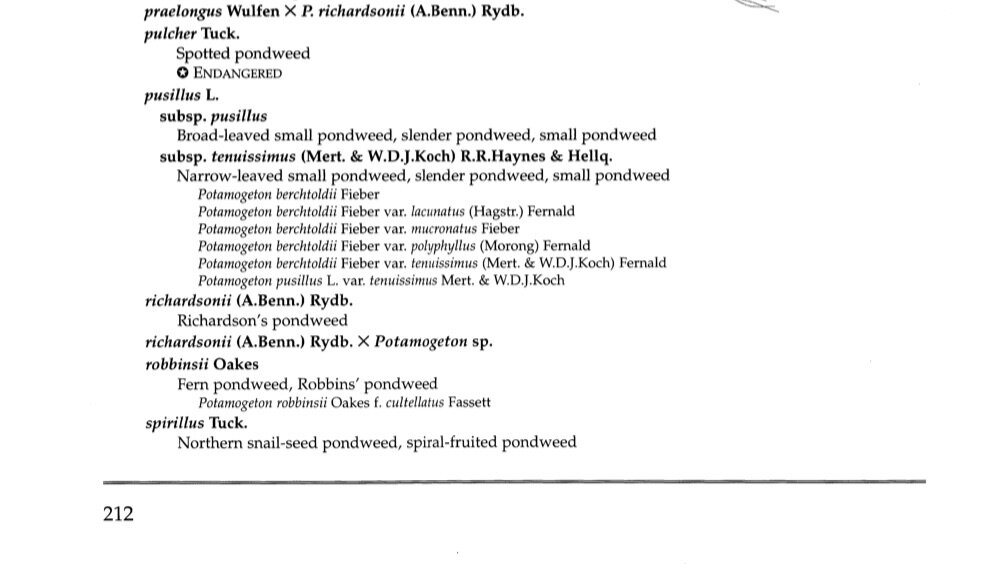
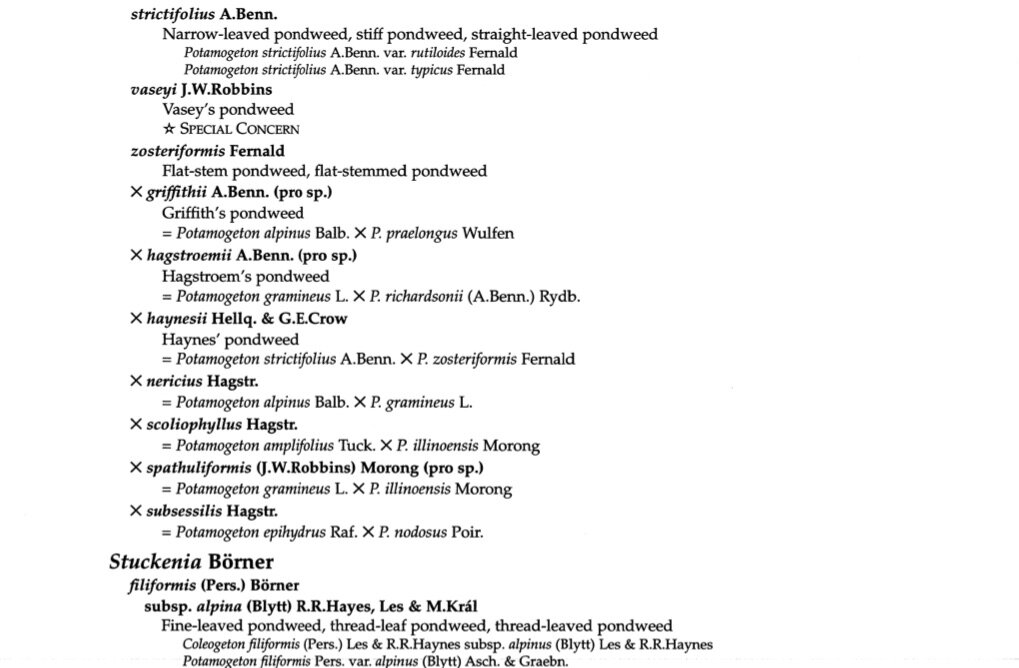
Last edited:
hydrophyte
Member
- Joined
- 22 Aug 2009
- Messages
- 1,093
For comparison here are the species from a Institute of Botany, National Academy of Sciences of Ukraine 1999 checklist. It is interesting to note the overlap from the North American species listed above. How have these plants dispersed across the ocean and between continents?
(Source: (PDF) Vascular Plants of Ukraine. A Nomenclatural Checklist)
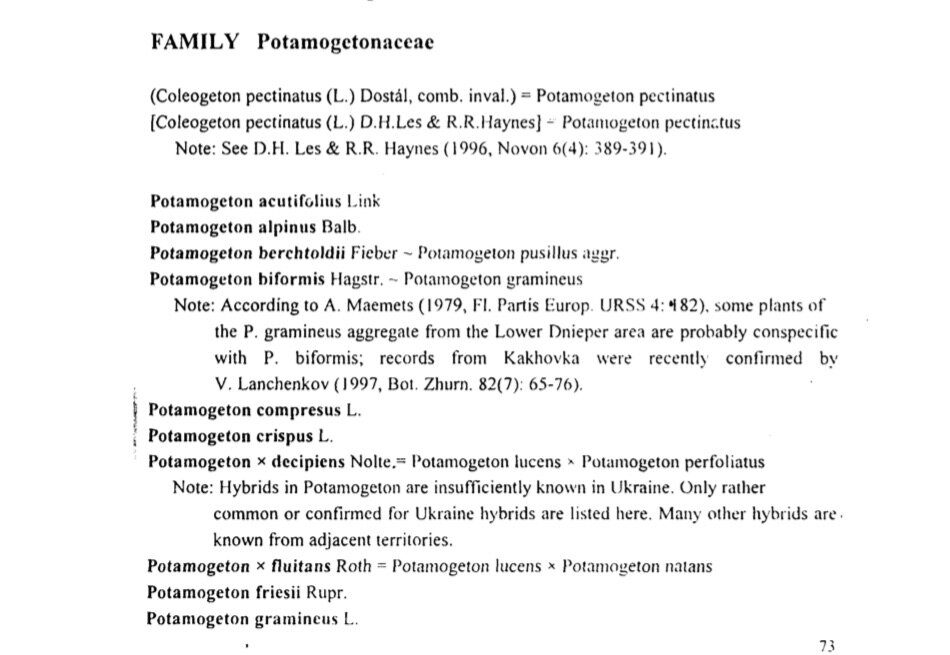

(Source: (PDF) Vascular Plants of Ukraine. A Nomenclatural Checklist)


Last edited:
It's my view that the interesting botany of aquatic plants is an area we could explore quite a lot more as aquascaping hobbyists. And you have some good ones listed here!
Sparganium are quite intriguing plants and among the "weird Monocots". Do you have this growing as an emergent, or fully submersed? I tried this same species riparium-style some time ago, but it didn't take.
Potamogeton is another compelling group. As far as I can see, there are only two species of these in the hobby, one of which is a nasty invasive plant in my area and unlawful to trade. This genus is well-represented in temperate lakes and rivers and could be a fun project for exploring wild habitats and aquarium culture. Potamogeton are characteristic flora for many of the cleaner lakes of forested areas up in the northern part of our state. I have a tall column tank sitting empty that would make a nice enclosure for them and maybe I will try to make some time for this next summer. Here's the checklist of species + varieties and hybrids for our state.
Sparganium or bur-reed was a spontaneous trophy (to be honest). I caught a small submerged plant in a landing net when hunting for fish fry and I didn't hope that it can be a successful plant in the aquarium hobby. But after 1.5 year in my biotope aqua it's feeling and looking really great (after previous winter's terrible blackouts)! I don't know why but submersed forms of our local plants never go emergent in home aquaria and emergent plants die indoors...
Potamogetons (pondweeds) are harder to grow than most of the tropical aquatic plant we see in the hobby. Plants of this genus are common in our lakes and rivers but don't like artificial conditions. I made attempts to grow all species available in my area, and this is my second successful experience. Beside these (P. nodosus and P. perfoliatus) I had positive experience with P. natans and P. crispus (I kept them in a balcony windowsill aqua during previous season). All other species slowly degraded. The most important secret to the success with pondweeds is planting small fresh sprouts with strong roots. Big plants have no chances.
The presence of the same plant species in the North American and European continents are a mystery for me too (though their DNA may be different and modern scientist can divide them into separate species). I used this fact some years ago to recreate a Venezuelan lagoona for my Endlers (Poecilia wingei) biotope. I made the list of species available in both areas and collected desired plants from a forest nearby.
Steve Buce
Member
Tank looks great, a credit to you
Sad "anniversary" for the Ukrainians today: 700 days since the start of the russian full scale invasion war.
700 DAYS OF BIG WAR. 10 YEARS OF BETRAYAL
This season I am busy with the series of posts about European local fish acclimation. And I planned to publish the second post in this series today. But yesterday in the morning russians made another massive missile attack on our cities killing many Ukrainians. And they plan a new missile attack this week ruining my plans.
It is impossible to plan, work and share when your neighbours die in the war and I can be next.
But I promise to share my experience as soon as I am able to.
700 DAYS OF BIG WAR. 10 YEARS OF BETRAYAL
This season I am busy with the series of posts about European local fish acclimation. And I planned to publish the second post in this series today. But yesterday in the morning russians made another massive missile attack on our cities killing many Ukrainians. And they plan a new missile attack this week ruining my plans.
It is impossible to plan, work and share when your neighbours die in the war and I can be next.
But I promise to share my experience as soon as I am able to.
I still cannot get rid of Attention deficit disorder and still have alot to do to finish my Local fish acclimation project 😥.
But I have a bit to share. This post in my blog is about the temperature acclimation - the first problem we encounter when bring local fish to home aquarium in a cold period of the year.
1. ACCLIMATION OF TEMPERATE FISH: TEMPERATURE
Do you have a similar experience and your own tips?

This mesmerizing young female of the narrow-clawed crayfish (Astacus leptodactylus) was brought and successfully acclimated in my biotope aquarium in autumn 2022 and grew up from an nail-long kid to adult crayfish during the previous winter.
But I have a bit to share. This post in my blog is about the temperature acclimation - the first problem we encounter when bring local fish to home aquarium in a cold period of the year.
1. ACCLIMATION OF TEMPERATE FISH: TEMPERATURE
Do you have a similar experience and your own tips?

This mesmerizing young female of the narrow-clawed crayfish (Astacus leptodactylus) was brought and successfully acclimated in my biotope aquarium in autumn 2022 and grew up from an nail-long kid to adult crayfish during the previous winter.
LondonDragon
Member
I kept a blue one before and loved it, they have such great characters, but make sure your tank is fully sealed, any holes and it will escape lolThis mesmerizing young female of the narrow-clawed crayfish (Astacus leptodactylus)
Mine outgrew the 60l tank when it got to 25cm in size, took it back to the LFS! Would love to keep one again!
hydrophyte
Member
- Joined
- 22 Aug 2009
- Messages
- 1,093
Sparganium or bur-reed was a spontaneous trophy (to be honest). I caught a small submerged plant in a landing net when hunting for fish fry and I didn't hope that it can be a successful plant in the aquarium hobby. But after 1.5 year in my biotope aqua it's feeling and looking really great (after previous winter's terrible blackouts)! I don't know why but submersed forms of our local plants never go emergent in home aquaria and emergent plants die indoors...
Potamogetons (pondweeds) are harder to grow than most of the tropical aquatic plant we see in the hobby. Plants of this genus are common in our lakes and rivers but don't like artificial conditions. I made attempts to grow all species available in my area, and this is my second successful experience. Beside these (P. nodosus and P. perfoliatus) I had positive experience with P. natans and P. crispus (I kept them in a balcony windowsill aqua during previous season). All other species slowly degraded. The most important secret to the success with pondweeds is planting small fresh sprouts with strong roots. Big plants have no chances.
The presence of the same plant species in the North American and European continents are a mystery for me too (though their DNA may be different and modern scientist can divide them into separate species). I used this fact some years ago to recreate a Venezuelan lagoona for my Endlers (Poecilia wingei) biotope. I made the list of species available in both areas and collected desired plants from a forest nearby.
I should try Sparganium again someday. Definitely an unusual plant.
Aquatic plants must disperse between water bodies to a certain degree with seeds and parts in the plumage of Ducks and other water birds. Fish, especially Cyprinids and others with sticky eggs, also get around this way. I imagine a few freshwater aquatic plants may have also passed between the continents via the Bering Land Bridge.
I have an updated idea for an estuary setup with mesohaline (moderate salinity) brackish water to somewhat resemble a seagrass meadow, but with easier plants. Areas of the Black Sea are among places mentioned with this kind of environment. So is the Indian River Lagoon in Florida and Chesapeake Bay.
https://dnr.maryland.gov/waters/bay/Documents/SAV/complete_sav_key.pdf
I found one of the related plants on my wanted list on eBay. This is Potamogeton perfoliatus, which can supposedly grow OK in salinity up to 15ppt.
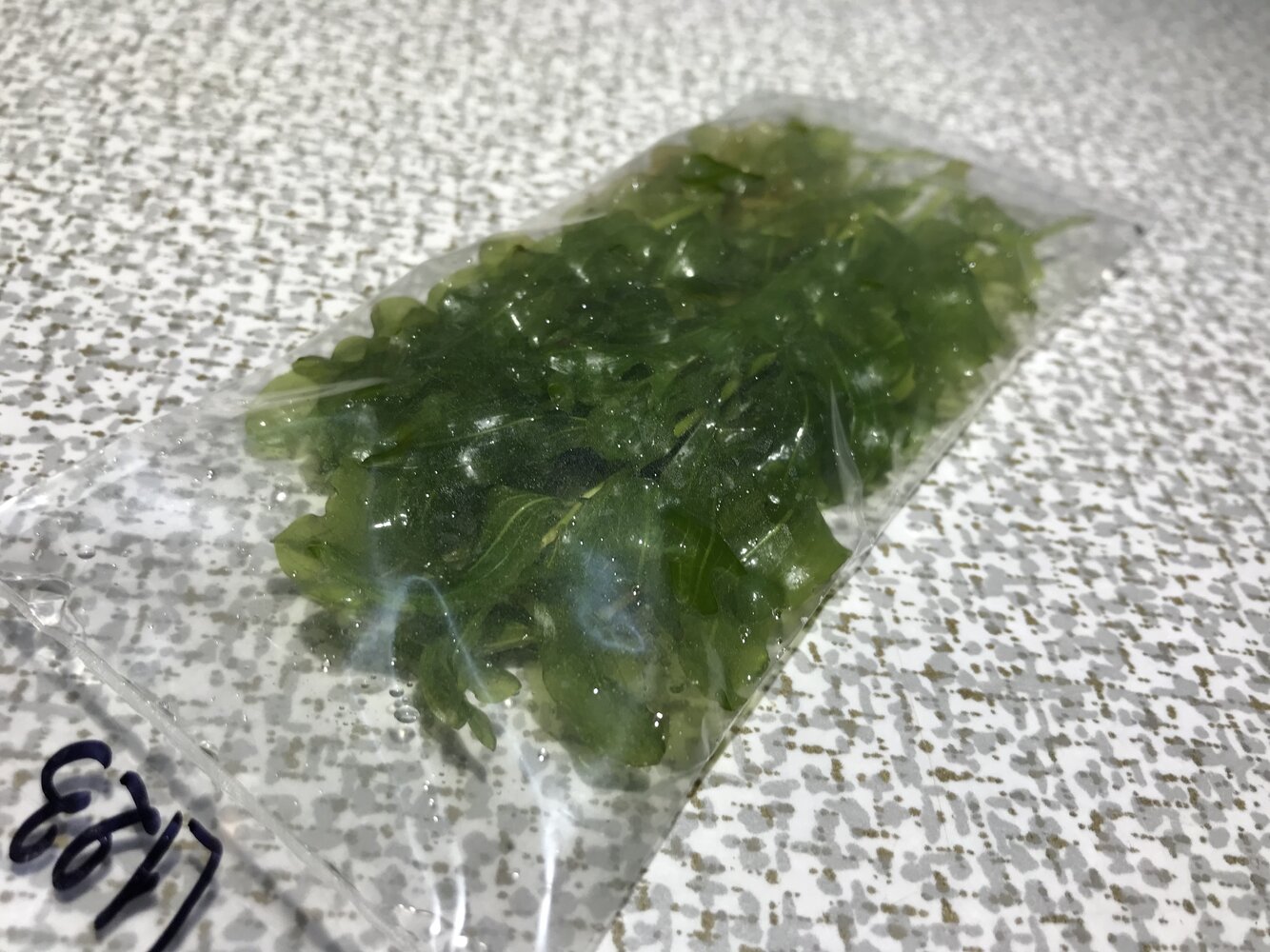
Here's a few more I hope to round up and try.
- Zannichellia palustris
- Stuckenia pectinata
- Ruppia maritima
- Eleocharis parvula
- Halodule wrightii
Many years ago I also enjoyed the company of a blue crayfish. I bought it on an impulse and soon had to return to the market seller as the creature was too big for my guppy nano tank 🙁I kept a blue one before and loved it, they have such great characters, but make sure your tank is fully sealed, any holes and it will escape lol
Mine outgrew the 60l tank when it got to 25cm in size, took it back to the LFS! Would love to keep one again!
What I remember is that the crayfish was very active, cute and friendly.
On the contrast this one was wild, and this wilderness influenced its behaviour. It was extremely cautious, timid and frightful. It never got used to my presence, and when I came close to the aquarium the crayfish always hid in its self made shelter of driftwood and sand.
Another difference between the blue and narrow-clawed crayfishes is perhaps that the second one in my aquarium never tried to escape. It trained itself in hardscaping and shelter building, it defended own territory from any trespassers, often molted but never tried to escape. My aquarium is open and the crayfish liked to rest on the top of the internal filter with its claws and antennas above water level, but never higher.

I should try Sparganium again someday. Definitely an unusual plant.
I have an updated idea for an estuary setup with mesohaline (moderate salinity) brackish water to somewhat resemble a seagrass meadow, but with easier plants. Areas of the Black Sea are among places mentioned with this kind of environment. So is the Indian River Lagoon in Florida and Chesapeake Bay.
https://dnr.maryland.gov/waters/bay/Documents/SAV/complete_sav_key.pdf
I found one of the related plants on my wanted list on eBay. This is Potamogeton perfoliatus, which can supposedly grow OK in salinity up to 15ppt.
Here's a few more I hope to round up and try.
I am inland and far from the sea coast, but Z. palustris and S. pectinata both occur here. I think the latter actually grows right in our creek just down the street. So I should be able to find them this summer. R. maritima is pretty much the most characteristic species for this estuary seagrass environment and I hope I can trade for it or find it for sale. E. parvula is among the aquarium sold as Dwarf Hairgrass. Halodule wrightii is a true seagrass, but apparently can grow in the lowest salinity among US seagrass species and overlap with the others here in the range of around 10-15ppt.
- Zannichellia palustris
- Stuckenia pectinata
- Ruppia maritima
- Eleocharis parvula
- Halodule wrightii
If we turn to the brackish waters of the Black Sea (and the Sea of Azov, it may be even more interesting for you) there are no brackish plants in it. None of the pondweeds is able to acclimatize and flourish in the water with salinity higher than 15 ppt. And I haven't seen any freshwater/brackish plant in the waters of the northwestern part of the Black Sea (with the lowest salinity).
- Zannichellia palustris is freshwater, found in rivers, and I really doubt its chances to grow in the brackish water.
- Stuckenia pectinata is extremely hard to keep even for freshwater biotopes
- Ruppia maritima looks a promising one and I also hope to get some for my own experiments
- Eleocharis parvula from a local marsh now happily grows in my blackwater biotope with ph <6, so I can't imagine it in a marine aquarium. But who knows...
Our Black Sea is dominated by the algae, the only higher plant species are Zostera marina and Zostera noltii. Both look pretty beautiful, they can tolerate wide range of salinity and are on my wishlist to get after our victory.
Pondweeds are quite tricky plants and need special care. Is the Potamogeton perfoliatus from your photo still alive?

These are my Potamogeton nodosus (left), Potamogeton crispus (right) and Neogobius fluviatilis, brackish goby fish


